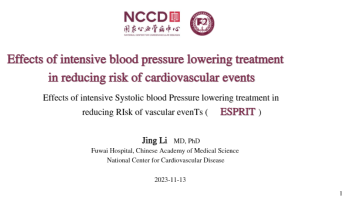ESPRIT: Intensive BP-Lowering Reduces MACE in Chinese Patients
The findings build on those from SPRINT, expanding the benefits to Asian patients and those with diabetes or a history of stroke.

PHILADELPHIA, PA—Among hypertensive patients with a high cardiovascular risk, intensive treatment to a systolic blood pressure goal below 120 mm Hg reduces major adverse cardiovascular events compared with a conventional goal of less than 140 mm Hg, the ESPRIT trial shows, mirroring the results previously seen in the landmark SPRINT trial.
ESPRIT, conducted in 116 sites across China, builds on the SPRINT findings by including an exclusively Asian population and also patients with type 2 diabetes or a history of stroke, who were excluded from the earlier trial. Overall, intensive management lowered the risk of MACE by a relative 12%, with a number needed to treat of 74.
Although there have been concerns about the safety of aggressively lowering blood pressure, safety was “very good” in ESPRIT, Jing Li, MD, PhD (Fuwai Hospital, Beijing, China), reported here at the American Heart Association 2023 Scientific Sessions.
For every 1,000 patients treated to the intensive versus conventional systolic BP goal for 3 years, she estimated, there would be 14 major vascular events and eight deaths avoided at the cost of three additional serious adverse events involving syncope.
“Our study generates new evidence about the benefit and the safety of treatment targeting systolic blood pressure below 120 mm Hg among [a] diverse Asian population,” similar to what has been seen among individuals with other ethnic backgrounds, Li said.
That’s important, commented Eugene Yang, MD (University of Washington, Bellevue), chair of the American College of Cardiology’s council on the prevention of cardiovascular disease, because it hadn’t been clear whether the SPRINT findings could be applied to Asian individuals. Asians—particularly East Asians—tend to have a lower risk of CV mortality compared with other groups, he added.
Even though the reduction in major vascular events observed in ESPRIT was “relatively modest,” Yang said, it indicates a clear benefit. That is consistent, too, with the reduction in cardiovascular events with intensive BP-lowering observed in the STEP trial of older Chinese patients, he noted.
The validation of the approach across multiple trials involving Asian patients “makes me feel better that we should be treating aggressively,” Yang said.
The ESPRIT Trial
ESPRIT included 11,255 patients 50 or older (mean age 65 years; 41% women) who had a systolic BP of 130 to 180 mm Hg at baseline and either established CVD or at least two major cardiovascular risk factors. Average baseline BP was 147/83 mm Hg. Overall, 39% of patients had diabetes and 27% a history of stroke. ESPRIT participants tended to have better renal function than those in the SPRINT trial, with a lower proportion of patients with an estimated glomerular filtration rate below 60 mL/min/1.73 m2 (6% vs 28%).
By 1 year, patients treated to a systolic BP goal less than 120 mm Hg had significantly lower readings compared with those treated to below 140 mm Hg (mean 120.3 vs 135.6 mm Hg), and that was sustained through a median follow-up of 3.4 years.
The primary outcome was a composite of MI, coronary and noncoronary revascularization, hospitalization or emergency visit for heart failure, stroke, or CV death. The rate was lower in the intensive arm (3.2% vs 3.6% per year; HR 0.88; 95% CI 0.78-0.99). Findings were consistent across subgroups defined by baseline coronary heart disease, stroke, diabetes, and systolic BP.
There were no significant differences between trial arms for most of the components of that endpoint, although intensive treatment significantly reduced CV death (0.3% vs 0.5% per year; HR 0.61; 95% CI 0.44-0.84). All-cause death was lower as well (0.9% vs 1.1% per year; HR 0.79; 95% CI 0.64-0.97).
Safety of intensive treatment was “better than expected,” Li said. Serious adverse events occurred in about 42% of patients in each group. Intensive treatment was associated with a higher rate of syncope (0.4% vs 0.1%) and of emergency visits/serious adverse events related to syncope (0.5% vs 0.2%), but there were no differences between groups in other serious adverse events, including electrolyte abnormalities, injurious falls, or acute kidney injury/acute renal failure.
Rates of all of these safety outcomes were lower in ESPRIT than they were in SPRINT. Emergency visits/serious adverse events involving syncope, for instance, were seen in 3.5% of SPRINT participants in the intensive arm and 2.4% of those in the conventional arm.
Global BP Control Remains a Problem
Discussing the results after Li’s presentation, Paul Whelton, MB, MD (Tulane University School of Public Health & Tropical Medicine, New Orleans, LA), president of the World Hypertension League, pointed out that there have been four randomized trials comparing a systolic BP goal of less than 120 mm Hg with a goal of less than 140 mm Hg—ACCORD BP in diabetic patients, SPRINT in nondiabetic patients, RESPECT in stroke survivors, and now ESPRIT.
Although not all of the differences are statistically significant, each trial suggests a reduction in CV events with intensive treatment, Whelton said. “Guideline committees and clinicians will have to consider that and consider perhaps a revised systolic blood pressure treatment target.”
He noted that there are results coming from three large trials—OPTIMAL Diabetes and OPTIMAL Stroke from Brazil and BPROAD from China—that will provide more insights.
In the meantime, ESPRIT provides “very reassuring” information on the safety of aggressive BP management, Whelton said. “But I think we have to look at the balance of beneficial [effects] and adverse events. They seem very positive, but of course additional analysis from ESPRIT and from the new trials will be helpful.”
Additional research addressing the impact of intensive BP-lowering on cognitive function and dementia, as well as the long-term implications of the small changes in renal function associated with more-aggressive treatment, is needed, he said.
Whelton ended his comments by taking a broader view of hypertension management around the globe, noting that BP control rates—even using conventional goals—remain suboptimal and have worsened in recent years.
“These are great new findings, but we’re faced with a dilemma that we’re not even doing well at the 140/90 [mm Hg] range. Things are getting worse,” Whelton said. “So this is another call to action.”
Todd Neale is the Associate News Editor for TCTMD and a Senior Medical Journalist. He got his start in journalism at …
Read Full BioSources
Li J. Effects of intensive blood pressure lowering treatment in reducing risk of cardiovascular events. Presented at: AHA 2023. November 13, 2023. Philadelphia, PA.
Disclosures
- ESPRIT was funded by the Chinese Ministry of Science and Technology, with additional research funding coming from Servier (Tianjin) Pharmaceutical Co. and Lilly for education and BioValley for assessment of medication effects. Study drugs were provided by Changzhou SIYAO Pharmaceutical Co., Shanghai Shyndec Pharmaceutical Co., Tianjin Lisheng Pharmaceutical Co., and Servier (Tianjin) Pharmaceutical Co.
- Whelton reports no relevant conflicts of interest.






Comments